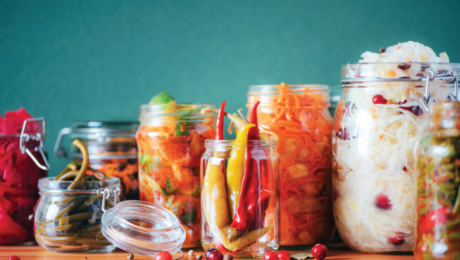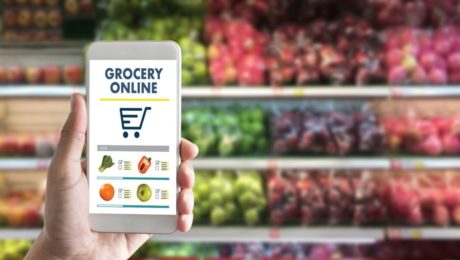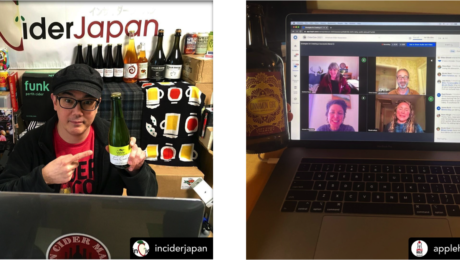The Flavors of Fermentation
From pickling foraged plants to experimenting with koji to vacuum-sealing tempeh, more chefs are experimenting with fermentation. Insights “for menu developers seeking unique concepts and ingredients” were shared during a session at the Research Chefs Association’s RCA+ virtual conference.
Sandor Katz, noted author and educator, discussed how research kitchens can increase their fermentation activities, from creating interesting flavors to expanding food preservation.
“[Fermentation] can elevate the plainest of foods into flavor sensations,” Katz said. “Its uses in culinary traditions around the world are incredibly diverse, and yet visionary chefs are experimenting with exciting new applications of fermentation.”
Read more (Food Business News)
- Published in Food & Flavor
Building a Fermented Brand
Behind every fermented food or beverage is intriguing science that creates a pleasantly tangy taste. Customers want to know all about that chemical process, right?
No. Stop geeking out and appeal to the foodie instead.
“This is about the joy of eating, and so when you over-science me and you over-gut me, I forget the joy of eating. Remind yourself that your most important message is how pleasant, how tasty, how engaging, that’s the pleasure of eating, and then you can tell me how you make that pleasure,” says Sasha Strauss, managing director at Innovation Protocol (a marketing consulting & design agency). Strauss shared his brand strategy tips in the TFA webinar Building a Fermented Brand. He stressed fermented brands need to avoid getting stuck in the “scientific nuance of how you make your products. I’m not saying delete the science, just don’t make it the marquee.”
Alex Corsini, founder of frozen pizza company Alex’s Awesome Sourdough (and TFA Advisory Board member) agrees. Corsini, who moderated the webinar, says he began his brand with a heavy emphasis on the science of fermenting sourdough.
“Our customer didn’t really respond to that. And that’s something I see in fermentation all too often, is people aren’t selling the actual benefit. They want to understand the benefit, so that’s what you lead with,” Corsini advises.
If you’re selling kombucha, for example, share that it’s a feel-good product that will make you feel better than a soda, Corsini says. Don’t make your selling pitch the SCOBY’s technical specifications.
Teach, Don’t Sell
“I don’t understand fermentation. I don’t understand the health benefits. I don’t understand its cultural origins. I don’t understand what section to buy it in. I don’t understand what to eat it with or who to serve it too. Your first duty as a brand is to help me make sense of this, help me understand it,” Strauss says. “It’s not your job to be the sexiest, raciest, the most innovative, it’s your job to help me understand. And where understanding sits in the consumer’s mind is where buying behaviors originate. So the first and most important duty of your brand is to simply help me not feel alone, help me not feel confused, help me not feel overwhelmed.”
By educating the consumer, by inspiring them to learn about fermentation, “they will be indelibly connected to you,” Strauss continues. “They will prefer you. They won’t wonder if your price is a penny cheaper, they’ll prefer you because you’re who they learned from. We buy who we learn from.”
There’s not enough room on a label to detail all the health benefits or the scientific details of a product. But this information can go on a brand’s website, social media page or table-top display at a trade show or farmer’s market.
“I hope that your audience doesn’t hear from you just once,” Strauss says. They should find a video of your product on Instagram, find recipes on your website and see an ad in the local paper. Brands need to create multiple opportunities to engage, “don’t try to cram all of your value in a single channel.”
A New Economy
The COVID-19 pandemic has permanently changed the economy. Consumer lifestyles have changed, too, and these new behaviors create opportunities, especially for fermented products that are healthy and flavorful.
“Historically, if you were trying to build a consumer packaged goods brand, it was really about your resume, your long list of accomplishments , your heritage in farming, your understanding of the chemistry and that was what marked the person, the business, the brand,” Strauss says. “But actually now, it’s really about how you resonate, how I connect with you, how you inspire me, and that doesn’t require a long history, that requires a contemporary participation.”
“In a world where the audience is starting and ending their search digitally, each of the things that you share, post, write about, blog about, video dialogue about, those things are little breadcrumbs that will never go away,” Sasha says. “They’re little trails that lead to your brand, lead to your resources, lead to your understanding and this is powerful.”
Consumers rejected traditional brand loyalties this past year. They’re increasingly open to new brands, curious about new cultural flavors and want healthy food. Critically, Strauss points out, they want to purchase from socially responsible brands. “In a post-covid era, we want a brant to also do good,” he says.
Producers must make conscious choices about the farmers they use — how are they improving soil health? What is the environmental impact of their distribution line?
“Understand you have to make an impact, somehow do good for the world while building business,” Strauss says.
- Published in Business
The “New Normal”for CPG Companies
Don’t expect people immediately to dump their sourdough starters and crowd restaurants when the Covid-19 pandemic is over. In a U.S. consumer trends survey, 42% of people said they plan to cook more at home post-pandemic. This news is great for Consumer Packaged Goods (CPG) brands.
From record sales to supply shortages to new safety regulations, the retail grocery business was changed dramatically by the pandemic in 2020. But CPG companies experienced phenomenal growth: sales rose over 10% — more growth in one year than in the four-year period from 2016 to 2019. Though pandemic stockpiling (fingers crossed) likely will not recur in 2021 , CPG sales show no signs of slowing down. A mere 7% of Americans said they’d cook less after the pandemic than before. Consumers are buying CPGs more than ever. And they’re not staying loyal to their favorite brands — over 50% of respondents said that they are willing to try different products, and 66% of them stuck with those new brands.
Fermented CPG brands are in a great spot to take advantage of these trends. Healthy foods gained significant share in the food market in 2020. The pandemic propelled fermented food and beverage into the spotlight. More Americans began experimenting with healthier eating during the pandemic, and now they’ve adopted it as a habit.
What does this mean for the future of CPG brands? Here are four ways they must adapt to the “new normal”:
- Sales via Multiple Channels
Consumers won’t be shopping for your products only in brick-and-mortar stores. More consumers than ever are buying through ecommerce. Digital grocery sales were a niche category before the pandemic — now, CPG food and beverage sales are estimated to top $100 billion in 2021.
Food and beverage sales became the largest CPG online segment in 2020.
Direct-to-consumer (DTC) sales also shifted into high gear. Consumers turned to DTC during the pandemic to get their favorite products straight from the manufacturer. Good examples are kombucha producers selling bottles directly from the brewery and a sauerkraut maker shipping to consumers from their kitchen. An analysis by Retail Dive found direct-to-consumer businesses during the pandemic fared better than did traditional brick-and-mortar retailers.
But this doesn’t mean CPG brands should abandon selling in grocery stores.
According to Deloitte’s 2021 Consumer Product Industry Outlook, four out of five companies say “resetting their go-to-market strategy is critical to meeting their objectives; however, only half rated the current maturity of their related capabilities as high.” A majority of CPG companies surveyed say a bigger online and omnichannel presence will be a means of reaching consumers in 2021.
- Conscious Consumption
Consumers want to buy from brands that care about social and environmental issues. Societal inequality and environmental impact are big concerns to many consumers, and they are spending their dollars on ethical brands willing to put their money where their mouth is.
Deloitte found nine in 10 consumers say the pandemic is “an opportunity for large companies to hit ‘reset’ and focus on doing right by their workers, consumers, communities and the environment.” The CPG companies surveyed agree — three in four say establishing such initiatives in 2021 are a “strategy to place purpose alongside profit, express corporate values, and address heightened consumer attention to sustainability, social justice, equality, and environmental consciousness.”
Authenticity is key for proper brand activism. CPG companies need to be transparent with their consumers, integrating their social and environmental purposes into all parts of their business and organization. A brand that acts inconsistently will quickly lose trust with a consumer.
- Preference for Small Producers
CPG sales during the pandemic showed an interesting dichotomy: large companies had the highest dollar growth, but small companies – taken as a whole – gained meaningful share of market. A report by business consulting firm McKinsey & Company found market share of small companies during the pandemic increased from 18.2% in 2019 to 19.2% in 2020, while midsize businesses were flat and large companies fell from 51.2% to 50.5%.
More consumers did switch to new brands during the pandemic, but their primary reason was availability. This area is one where large brands have an advantage, as their greater resources should help them keep products on grocery store shelves.
- Supply Chain Improvements
Whether implementing new safety rules, finding sources with available products or switching packaging materials, every CPG brand had to adjust their supply chain in 2020. They are acting quickly to fix weaknesses exposed by the pandemic, and nine in 10 say they’re making significant progress.
CPG companies used to be praised for holding minimal inventories, but 2020 tested their resilience. Deloitte’s report explains: “Resilience is how companies keep their supply chains from breaking and restore them quickly when they do. It is also how they can gain the nimbleness and scalability to power new go-to-market approaches and innovative business models.”
Barb Renner, Deloitte’s vice chairman and U.S. leader of consumer products, says one of the biggest problems identified in their survey was an over-reliance on a small number of vendors. Most companies didn’t have backup plans. “If they were getting their product from a handful of vendors and one of those vendors had to close down, did they try to find an alternative source?” she asked.
CPG executives indicated supply chain resilience is important or very important for the company in 2021, with nine in 10 saying they are investing in improvements. Beyond creating reliable supply chains that can support their production, CPG companies need to be able to respond to demand and shift supply to new locations.
- Published in Business
Retail Sales Trends for Fermented Sauces
Shelf-stable fermented sauces are growing tremendously. In the past year, fermented sauces grew 41%, with sales reaching $275 million. Soy sauce still dominates with 70% of the market share, but sales of both fish sauce and gochujang increased over 50%.
“I think a lot of brands are thinking ‘Are we going to hang onto this new [normal], this new baseline?’ This is a segment of products that’s really having its baseline reset,” says Kevin Snodgrass, solutions architect for SPINS. Snodgrass shared insights in a TFA webinar, Retail Trends for Fermented Sauces. “Brands are going to continue to experience this great growth in the months and years ahead.”
The increase is significant — sales growth in the one year from 2019 to 2020 was 5.7%. This improvement is attributable to multiple trends across the food industry — more people are buying healthy food and cooking at home, the American kitchen is becoming more globalized, and more consumers are embracing the unique flavors of fermented sauces, especially those from Asia.
“It definitely coattails a lot on the acceptance and growth of the fermentation market as a whole,” says Jared Schwartz, a TFA Advisory Board member who moderated the webinar. Schwartz is the founder of fermented sauce producer Poor Devil Pepper Co., and director of operations and quality for Farm Ferments, a facility in Hudson, N.Y., that is home to Hawthorne Valley Farm. “As consumers are becoming more open to reaching for fermented foods, kind of the next step is adding a flavorful, fermented hot sauce.”
Brands Growing, but Room for More
The top 10 selling fermented sauce brands in both natural retail grocers (like Whole Foods) and traditional (MULO) outlets (like Wal-Mart and regional grocery chains) are all experiencing double-digit growth. “That’s a great sign,” Snodgrass notes.
Kikkoman, Bragg, San-J, Coconut Kitchen, Lee Kum Kee and Big Tree are among the top 10 brands in both the natural and MULO channels. Smaller brands like Red Boat, Mother-In-Law’s, Ohsawa and Yamasa thrive in the natural channel,; La Choy, BetterBody Foods and Chung Jung One are strong in MULO.
The category is ripe for continued innovation, Snodgrass says. Smaller brands can emerge, even with competition from larger, established brands, so it can be worthwhile to start a fermented sauce brand.
Label Claims & Consumer Education
SPINS found certain product attributes on fermented sauces help sales.. Certified gluten-free fermented sauces grew 40.8%; USDA organic, up 40% and non-GMO increased 33.8%.
Since many sauces don’t put “fermented” on their label, many consumers may not be aware they are, notes Snodgrass. He says that these products could benefit from using “fermented,” as it would suggest that there may be health benefits to the sauces.
Schwartz agrees. He points out Tabasco as a fermented hot sauce, even though producer McIlhenny Company doesn’t market it as such. Educating the consumer would also help the category. Probiotics are a selling point but they confuse buyers. And there’s a clear difference in health benefits between shelf-stable and refrigerated fermented sauces. Refrigerated sauces may have live, beneficial bacteria; shelf-stable ones are pasteurized, killing any good bacteria in the process.
“At the end of the day, I think it comes down to flavor,” Schwartz says. Fermented sauces are “funky and vinegar-free. It’s got this like natural layers of complexity that you can’t really achieve without fermentation.”
- Published in Business, Food & Flavor
The Future of Fermentation Biotechnology
Leaders in the biotechnology industry are calling fermentation “Agricultural 2.0.” As consumers continue to seek alternative protein and dairy options, more biotech companies are using fermentation to produce alt-proteins. Ricky Cassini, co-founder and CEO of natural food colourant start-up Michroma, says: “The fermentation space is thriving and there is a lot of progress around this technology.”
Here are three expected developments in fermentation processing this year:
- More dairy-free cheese products will enter the market.
- Price points for alternative proteins will drop as more players enter the market.
- Regulatory issues and naming conventions will gain in significance.
Read more (Food Navigator)
2021’s Top Superfoods
Fermented foods are still the top dog amongst nutritionists. For the fourth year in a row, fermented foods are No. 1 on Today’s Dietitian list of the year’s top superfoods.
The 9th annual What’s Trending in Nutrition survey, conducted by Pollock Communications for the magazine, polled more than 1,165 registered dietitian nutritionists (RDNs). They were asked for insight into consumers’ diets and, particularly, how food and beverage choices have changed during the pandemic.
“A year full of staying home and cooking more has influenced consumers to rethink their food and nutrition choices. In 2020, the food and beverage industry saw sales increases in products like green tea, as well as renewed attention on comforting, tried-and-true foods like dairy milk and healthy, fermented foods like yogurt,” says Louise Pollock, President of Pollock Communications. “The plant-forward trend continues to grow, as does demand for clean labels. Our trends survey findings reflect these significant changes caused by COVID-19 that will continue to affect eating habits and the food industry for years to come.”
Cookbook author Susan Jane White calls fermented foods the “celebrity superfood.”
“One of the many benefits of eating fermented foods is their gut-supporting role,” White says. “Of course, being uncooked, ferments have their goodness locked into a tango with all those beneficial bacteria. You’re left with a crisp tang that is both bewitching and nourishing.”
Changes to the top 10 superfood list reveals that consumers want more plant-based food. For the first time, nutrient-rich spinach and leafy greens made the list. Green tea jumped from No. 10 to No. 3. Superfoods, Today’s Dietitian notes, “have become dominant in consumer choices to help support immunity. From boosting gut health with fermented foods to reaping the benefits of antioxidants with blueberries and blunting inflammation with green tea.”
“We are witnessing unprecedented times in the world of nutrition, health and wellness,” says Mara Honicker, publisher of Today’s Dietitian. “As the world grapples with how to best manage health and longevity, consumer awareness of beneficial diets and ingredients is growing, and they will be looking to RDNs and the food industry to help navigate these shifting needs.”
- Published in Food & Flavor, Health
7 Takeaways for Cideries in 2021
Despite a year when cideries around the world were forced to close down taprooms and cancel restaurant sales due to the pandemic, cider sales grew 9% in 2020.
“I know some of you are barely hanging on — but you are hanging on,” said Michelle McGrath, executive director of the American Cider Association (ACA). “We did not waver, we held our shares and we kept growing.”
McGrath presented industry statistics at CiderCon 2021, the ACA’s annual global cider conference. Because of the ongoing coronavirus pandemic, the conference was virtual this year. Nearly 800 people from 18 countries and 41 states attended the three-day conference.
Smaller, local cider brands sparked consumer interest in 2020. Sales of regional cider brands grew 33%, while national brands declined 6%.
The impact of the pandemic, though, has been severe on certain sectors of the industry. On-premise cider sales (in restaurants, breweries and taprooms) declined nearly 70% from 2019.
“We’re resilient, we’re tough, we’re savvy. You couldn’t have predicted how your business would have stood up to a once-in-a-lifetime pandemic,” said Anna Nadasdy, director of customer success at Fintech, a data company for the alcohol industry.
Nadasdy’s keynote on expected consumer trends in 2021 cited the key drivers influencing consumer behavior — the economy, politics and natural disasters. Here are seven of her takeaways for cideries:
- Consumers Buying all Alcohol Types
Though consumers have long been loyal to one type of alcohol — beer, wine or spirits — the “beer guy or wine gal” label is disappearing. Over one-third of consumers are purchasing from all three major categories.
Hard seltzer is the third largest beer segment (16% of dollar share, behind domestic premium and imported beers), but it’s the fastest growing. This is exciting for cider makers, Nadasdy notes — hard seltzer in 2018 was the size of the cider market today.
- Fruit-Flavored Cider is Growing
Though apple cider still dominates the cider market with 52% of sales, fruit-flavored cider grew three points in the past year to 12% of sales. The top three fruit-flavored products are: Ace Pineapple Craft Cider, Incline Scout Hopped Marionberry Cider and 2 Towns Ciderhouse Pacific Pineapple Cider.
(Other products in the cider category include: mixed flavors, dry cider, seasonal cider/perry, herb/spice cider.)
- Cider is Making Waves in Craft Beer
Cider — tracked as part of the overall craft beer category — is proving a worthy participant.Cider has 11% of the dollar share, second only to the category leader, India Pale Ale (41% of the market).
“That’s really impressive for such a small base,” Nadasdy says. “Even though you guys are a smaller segment, you still have a lot to contribute to the overall beer category. And I think it’s important when you’re having these conversations with retailers that you are able to point out these wins.”
- Hard Kombucha is Gaining Ground
Cideries are competing with hard kombucha. Though hard kombucha is a fermented tea and not a cider, retailers consider hard kombucha and cider comparable drinks. And hard kombucha sales are growing quickly.
“Although small now, keep an eye on (hard) kombucha,” Nadasdy said.
- Prepare for Changed On-Premise Sales
Once wide-spread vaccination is in place and on-premise dining returns, expect fundamental changes such as more online ordering, healthier menu choices and a rise in food tech like tablet menus. The National Restaurant Association listed other significant changes that will impact cideries:
- Streamlined menus. There will be fewer menu items, with 63% of fine dining operators and half of casual and family dining operators saying they will reduce their offerings.
- Alcohol-to-go. Seven in 10 full-service restaurants added alcohol-to-go during the pandemic. Thirty-five percent of customers say they are more likely to choose a restaurant that offers alcoholic beverages to-go.
- Rosé-Flavored Cider is Out
Every brand of rosé-flavored cider is losing sales. The top three brands showing the most significant losses in this category are: Angry Orchard, Bold Rock and Virtue.
- Cans Are King
Cans are leading the dollar share of the market, growing at 1.5 times the rate of bottles. Six-pack (11-13 ounce) cans are now the top share item with 29% of total cider sales. This is followed by six-pack (11-13 ounce) bottles and 4-pack (18-ounce) cans. (These figures do remove shares of Angry Orchard, which sells in bottles. Because Angry Orchard dominates 40% of the cider market, they skew the data.)
- Published in Business, Food & Flavor
Global Fermentation: Today & Tomorrow
The health attributes and unique flavors of fermented food and drink are becoming increasingly more important to consumers. But, for fermentation brands to succeed in the food industry, they must prioritize their labeling and marketing, and focus on their environmental impact, says international food industry expert Lisa Moeller.
“Hopefully, it will be as advantageous to attach ‘Fermented’ as it is ‘Fresh Pack’ to shelf stable pickle products at some point in time,” says Moeller, speaking at a recent TFA webinar: Global Fermentation: Today & Tomorrow. “Never in our history has the power of positive change been more possible and necessary. I think there is an inherent history with fermented vegetables and a trajectory that can only take them higher going forward.”
After receiving her master’s degree in food science, Moeller spent 25 years working with Mount Olive Pickle Company in North Carolina. She later started her own company, Fashionably Pickled, where she consults to food brands on methods – such as assisting with traditional fermentation technology – for crafting better products.
Fred Breidt, microbiologist with USDA-ARS and a TFA advisory board member, called Moeller “one of the premiere pickle people in the United States,” and praised her for working around the world on a variety of fermentations.
Moeller shared three forecasts for fermented foods.
- Health Concerns Become More Important
Consumers are more concerned about their health during the COVID-19 pandemic. “Folks are looking to boost immunity, reduce their weight and they’re looking for nutritious options,” Moeller says.
People are also cooking more at home during the pandemic. Restaurant dining had continually increased over the previous two decades and, in recent years, only half the food eaten in the U.S. was purchased from a grocery store. But when COVID-19 hit, “this 23 year trend was blown out of the water,” says Moeller. By April 2020, 65% of the food consumed came from a grocery store, with less than 35% from restaurants.
“I think this trend gives the fermented vegetable arena great potential,” Moeller says. “Fermented vegetables can increase the shelf life of produce, they’re nutritious, and they can be turned into a wide variety of flavors. And I think for a time, people are going to be more interested in having a supply of things in their pantry when they don’t feel comfortable going to a grocery store.”
Increased research will help promote fermentation as a viable health food. There are still consumers who are off-put by fermentation, leaving room for brands to educate.
“Though a large part of the pickle industry is still involved with fermented cucumbers, it is not the leader in the retail category at this time,” Moeller says. “We don’t label ‘fermented’ in America. Lots of times with the cucumber industry, the fermented kind of becomes the offshoot. It’s kind of the have-to-do so you can produce all the fresh pack that you want and still have a home for others.”
- Labelling and Marketing Are Crucial
Food product labels and marketing must adapt to their local markets. Brands must create different labelling, packaging and marketing plans, depending on the country.
“There truly is no such thing as global tastebuds. But there are successful product adaptations,” Moeller says.
Consider Kentucky Fried Chicken (KFC) as an example. There are over 23,000 KFC locations in 140 countries, and the restaurants adapt to regional flavor preferences, selling different styles of food depending on the location. Coca-Cola is another example. With 500 brands in 200 countries, a can of Coke will taste different depending on the country where it was sold.
“Labelling is even more important when selling your brand. Know what is important to the folks that are going to make the decision to add you products to their store shelves. Whole Foods is different than Walmart,” Moeller adds.
She advises to never make a label too complicated. Yogurt sales are projected to drop by 10% by 2024 “and this is partially because there are too many choices and the category has gotten too complicated.”
- Environmental Concerns Lead to Upcycllng
The environment is a big topic of concern worldwide, Moeller says.The global food system accounts for 26% of greenhouse gas emissions, 40% of the food produced is never consumed and 78% of global consumers are concerned about the environment.
Upcycling will be the new food trend. Brands like Toast Ale (beer made from old bread) and RISE + WIN Brewing Co. (who recycle grain scraps to make granola and sweets) are already making waves in the industry. During the pandemic, chefs reported using fermentation more than ever before to make use of uneaten produce.
“There’s not a vegetable out there that could be turned into something else,” Moeller says. “Turning food waste into alternative products…I think it’s one of the most wonderful ideas, (brands) need to partner with the folks that they want to get these byproducts from.”
- Published in Business, Food & Flavor
Retail Sales Trends for Fermented Food and Beverage
Kimchi, fermented sauces and tempeh are driving growth in the fermented food and beverage category, a $9.2 billion industry that’s grown 4% in the last year.
“We’re excited about the growth potential for fermented food. While fermented food represents about 1.4% of the market today, there are segments that are tracking well above the growth of food and beverage [overall] that are poised for disruption in the future,” says Perteet Spencer, vice president of strategic solutions at SPINS. Spencer shared this information in a recent webinar hosted by The Fermentation Association. “There’s a ton of opportunity to scale and increase the footprint of these products.”
SPINS spent weeks working with TFA to define the fermentation industry’s sales, drilling into 10 fermented product categories and 57 product types. Wine, beer and cheese sales were excluded from the data — those categories are very large, and would obscure trends in smaller categories. (All three are also well-represented by other organizations.)
Pickles and fermented vegetables “is a space that’s seen [a] pretty explosive uptick in growth over the past year,” Spencer says. Every segment is growing — kimchi, sauerkraut, beets, carrots, green beans, sliced and speared pickles and all other vegetables — with pickles the largest, nearly 60% of the category.
The biggest growth, though, is coming from products other than pickled cucumbers. Kimchi is at the center of numerous consumer retail trends. Consumers are purchasing healthier food made with fewer ingredients, and they want food with international flavors. Kimchi makes up only 7% of the category, but sales are increasing at an explosive 90% growth rate.
More people are experimenting with fermenting while they’re at home during the coronavirus pandemic, but these kitchen DIYers do not appear to be detracting from sales.
“The more people make fermented foods, they appreciate what’s available in the store that maybe didn’t exist five or 10 years ago,” notes Alex Lewin, author and TFA advisory board member who moderated the webinar. “Anyone who has made kimchi knows it takes a lot, it makes a big mess, you get red pepper powder stuck under your fingernails and onion in your eyes. I can make kimchi (at home), and then once I’ve made kimchi, I’m like ‘Ok, maybe next time I’ll buy it.’”
Fermented sauces are also growing, up 24% in 2020. The largest segment in sauces is, of course, soy sauce, almost 85% of the category. But gochujang, less than 2% of the category, is increasing at over a 56% growth rate.
Versatility is helping sauces, pickles and fermented vegetables, Spencer says. Any food product with multiple uses is selling well. The condiments and sauces can be used as a topping on eggs, hamburgers or pizza, or mixed-in a salad, rice dish or soup.
Sake, plant-based meat alternatives and miso had combined annual growth of $75 million in 2020. Sake grew 16%, and both plant-based meat alternatives and miso each grew 26%.
Yogurt and kombucha still dominate the fermented food and beverage market. Yogurt is 81% of the market; if yogurt is removed, kombucha is 51% of the remainder.. Both have experienced slowdowns in sales from their peaks. Kombucha sales have slowed recently, as grab-n-go opportunities have shrunk during the pandemic.
Yogurt giant brands Chobani, Yoplait and Dannon still dominate the category, as do GT Kombucha, Health-Ade and Kevita reign for kombucha.
Spencer notes the 4% growth rate of fermented products overall would be higher without yogurt. It’s a large category that — despite an uptick in 2020 during the pandemic – has been fairly flat in recent years. Core (traditional) yogurt has been growing at a 1.6% rate; Greek yogurt, at about twice that pace. Those two segments account for roughly 80% of the category.
“This is an opportunity for disruption for emerging brands,” Spencer says. “We’re already seeing some of the legacy segments start to get disrupted by new innovation, so I’m excited to see the evolution of that innovation and where that goes and kind of what opportunities peek out of that.”
“Overall, we’re seeing historically small segments gaining traction in the marketplace,” Spencer adds. “The pandemic has brought a renewed consumer focus on the fermented space.”
Though fermented products have an added healthy benefit, customers are looking for delicious flavor first.
“In these fermented categories we covered today, taste first is always really important. I think people are going to these categories for different taste experiences,” Spencer says. “If you can level up with a functional benefit, that’s fantastic, but we have to balance the taste first. If it’s highly functional but doesn’t taste good, it just doesn’t have the same success.”
- Published in Business
Pandemic Prompts Premium Purchases
More Americans are purchasing premium foods during the pandemic. Growth is fueled by Millennial consumers looking to have an “experience” from home, eating fancy food from their kitchen table during the pandemic rather than going out. Many fermented products are considered premium. According to market research firm IRi, five of the top 15 food categories with a “premiumization” effect are fermented products: spirits, beer/ale/cider, wine, coffee and yogurt.
Read more (IRI Worldwide)
- Published in Business, Food & Flavor










